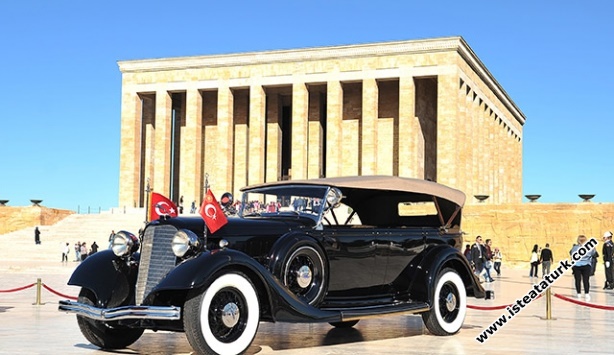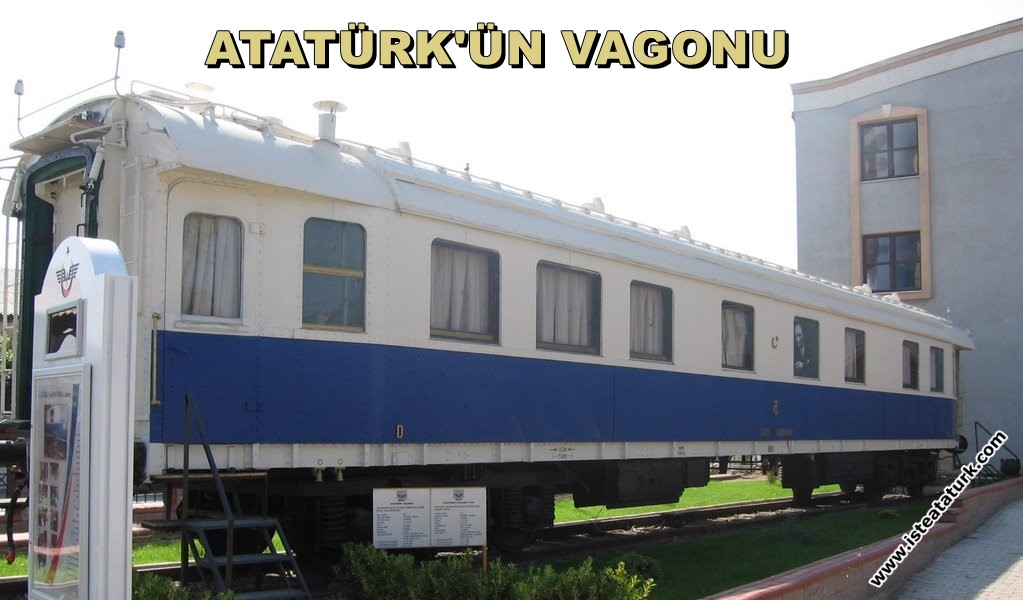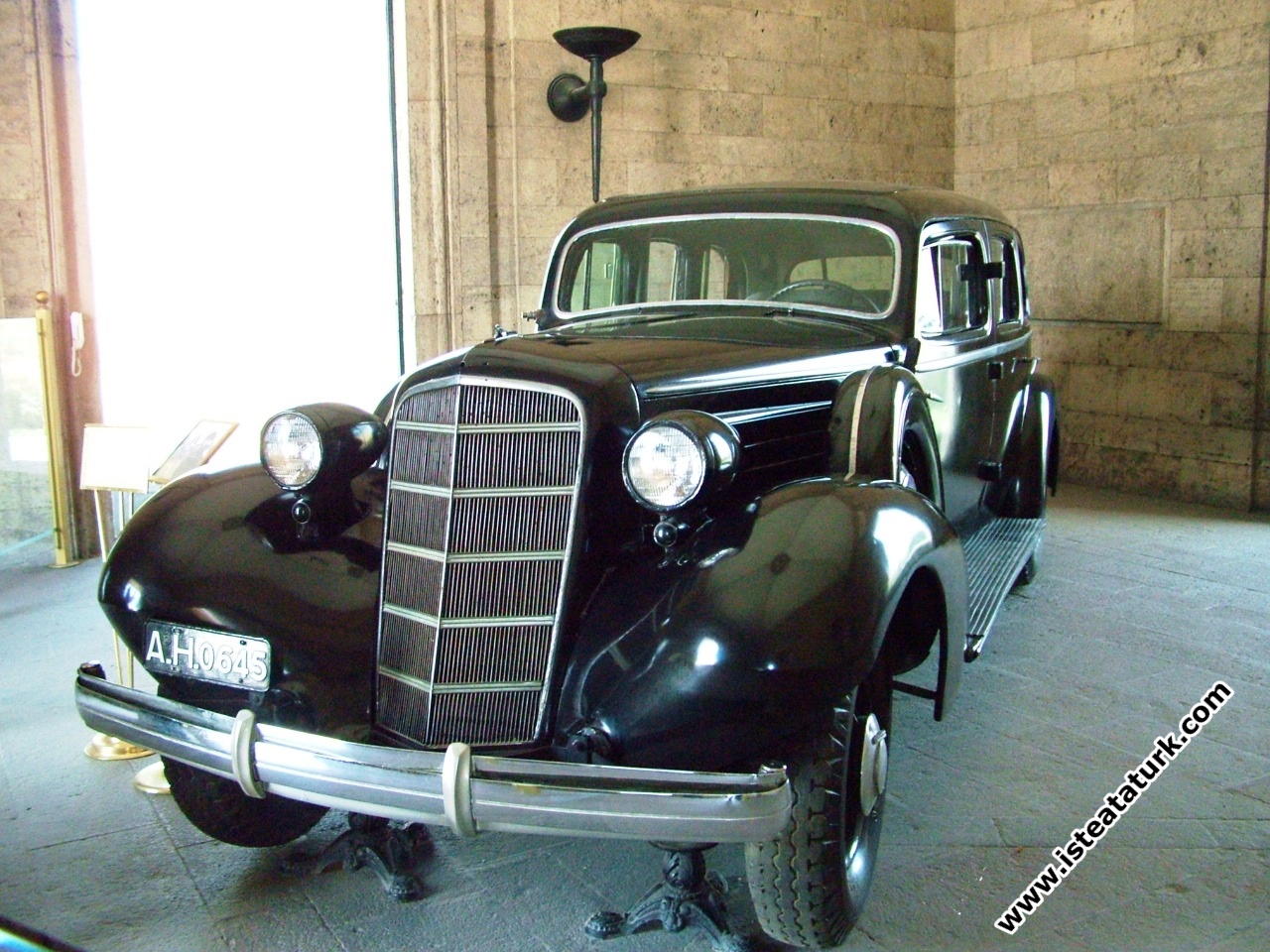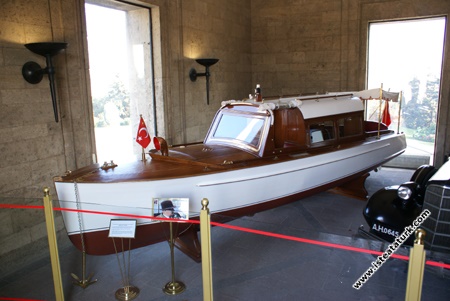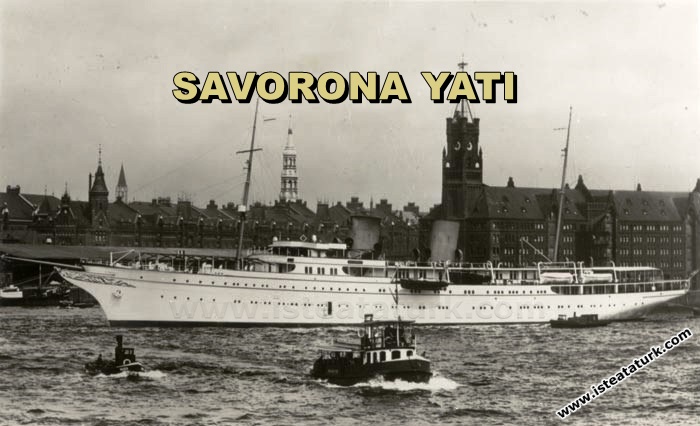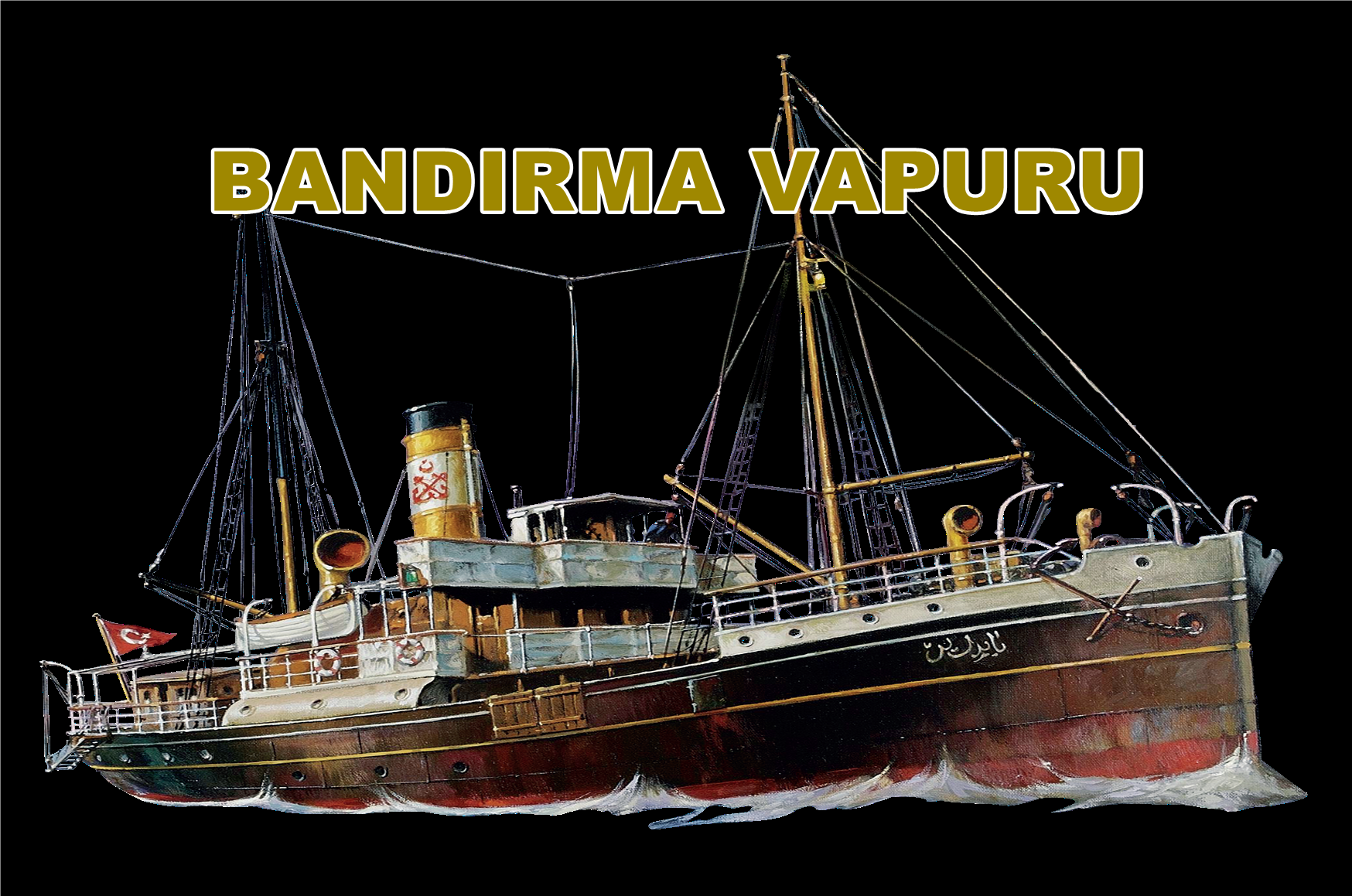
Atatürk and Bandırma Ferry
Character Size
Atatürk and Bandırma Ferry
HISTORY OF THE BANDIRMA FERRY
Bandırma Ferry, which brought the great leader Mustafa Kemal Atatürk from Istanbul to Samsun with his staff as the 9th Army Inspector (Mirliva), took its place in history by performing a very important task on the road to the Independent Republic of Turkey.
The ship was born in Glasgow, England in 1878 (after Scotland declared its independence, this area came within the borders of Scotland) Mac. Intyre Paisley - Huston and Cardett was built as a 279 gross ton passenger and freight ferry with 21 row numbers at the ship benches. The original owner of the ship, Dussey and Robinson, operated the ship for 5 years under the name "Torocaderto".
It was sold to H. Psicha Preus Company in Greece in 1883. Taking the name "Kymi", the ship's registration in London was taken to the Port of Piraeus.
In 1890, the H. Psicha Preus firm bought the ship, another Greek firm, Cap. It was sold to Andereadis firm, sank as a result of accident on 12 December 1891, and was floated in the same year. It was sold to the firm "Istanbul Rama Derasimo" under the name Kymi and registered in the port of Istanbul.
In 1894, the registration in Piraeus Port was transferred to "Idare-i Mahsusa", which means Maritime Routes at that time, and the Turkish flag was hoisted and its name was changed from "Kymi" to "Panderma". On the shores of the Sea of Marmara, he made cargo and passenger voyages between Tekirdağ, Mürefte, Sarköy, Karabigah and Erdek.
The name of the ship was changed to "Panderma", "Bandırma" when the status of the Special Administration changed and became the "Ottoman Navigation Administration" (Ottoman Maritime Administration) on October 28, 1910, and became a mail ferry.
After bringing Atatürk and his brothers in arms to Samsun on 19 May 1919, he continued his postal services. In 1924, it was taken out of service by the "Turkish Navigation Administration".
It is stated in the information obtained that it crashed several times after taking the name of Bandırma, crashed into the British-made E11 model submarine during the cargo transportation period, was about to sink as a result of the torpedo it fired, and then had a major malfunction in its engine.
In 1925, the ship was sold to Bozmacı İlhami (SÖKER) to a Turkish ship owner, and it was scrapped by the same shipowner within 4 months in Haliç Fenerin.
Unknown Aspects of Bandırma Ferry Journey
1914 - 1918 The First World War was lost, the Armistice of Mudros was signed, the Ottoman Empire was disintegrated, the Lightning Armies were destroyed on 7 November 1918 and Mustafa Kemal Pasha came to Istanbul. While the navy of the occupying forces was entering Istanbul from Haydar Pasha offshore by chance, this appearance greatly upset and affected Mustafa Kemal Pasha. He used the famous word "They Go As They Come" at that time. Meetings were held with his close friends Ali Fuat Pasha (Cebesoy), İsmet Bey (Inönü), Rauf Bey and other close friends in their house in Şişli for the salvation of the country, and solutions were sought. On the one hand, the occupation forces command "Sadaret", With the application (to the prime minister), it is complained that the Greek villages are constantly attacked by the Turks and that the security in the vicinity of Samsun is disturbed, and that the public order cannot be maintained by the local administration. The Metropolitan of Trabzon and Polathane "Hirisantos" gave the peace conference to the Muhtar as the delegate of the Greeks under captivity, otherwise there were threats that the situation would be seized by the occupation forces. The young general Mustafa Kemal Pasha, who was famous for his battles in the Gallipoli peninsula, was loved and respected by the people, especially by the army. In the Ottoman state, he was known as the most reliable person among the notables of the state, including Sultan Vahdettin, Grand Vizier Damat Ferit Pasha, Grand Vizier Damat Ferit Pasha, the Minister of Internal Affairs of the period, Mehmet Ali Bey.
Kazım Karabekir Pasha, who set out from Istanbul on April 12, 1919, reached Erzurum. His close friends were also suggesting that Mustafa Kemal Pasha should hurry to Anatolia. On May 1, 1919, Damat Ferit Pasha gave a tea feast to Mustafa Kemal Pasha in the Foreign Affairs Mansion. At the meeting, the public order situation in Anatolia was discussed. On May 12, 1919, Mustafa Kemal Pasha was appointed as the 9th Army Inspector. The assignment was communicated to all corps. Mustafa Kemal Pasha, who was busy with the preparations for crossing to Anatolia, was invited to dinner at Damat Ferit Pasha's mansion again, Erkan-ı Harbiye Chief (Chief of General Staff) Cevat Pasha (Shepherd) was present at the dinner. Mustafa Kemal Pasha said that he would prevent the confusion in Samsun and its surroundings by conducting on-site investigations. Cevat Pasha also requested a report on the gangs disturbing the peace in Samsun and Sivas. Mustafa Kemal Pasha would also ensure the security in question, as well as store the excess weapons and ammunition in the army's hands, and distribute the councils that were said to have been established in Eastern Anatolia.
Mustafa Kemal Pasha was also accepted by Sultan Vahdettin. He asked the Sultan Pasha to solve the problems that the British were complaining about. He gave the Pasha "Honorary Auxiliary". (They went to Germany with Mustafa Kemal Bey, who was his aide during the reign of Vahdettin in the First World War.) Sultan Vahdettin said exactly to Pasha: "Pasha Pasha, you can save the state." The response of the Pasha was as follows: "You can believe that I will not fail in my service, I will not forget for a moment what you have ordered me."
While he was busy with road preparations at his home in Şişli, he was also keeping in touch with his trusted friends. After the First World War, the Ottoman navy was heavily damaged. Existing ships and those in need of repair were also sent to Germany for maintenance purposes. In this respect, the Bandırma Ferry was assigned to take Mustafa Kemal Pasha and his comrades to Samsun by following the available means, and İsmail Hakkı Captain was appointed to the cavalry of the ship on 01.05.1919. The Banrma ferry, which was at 41 boats at that time, constantly worked on the shores of the Marmara Sea and did not sail to the Black Sea much. This ship, which had little strength and resistance to withstand the fierce waves of the Black Sea, could only operate in the Marmara Sea. (The ship had not sailed to the Black Sea much, but İsmail Hakkı, the captain has a good knowledge and He was a captain who knew me very well. He is a captain who has worked in the Black Sea for 5 years during his 21-year captainship and has traveled to India and the Far East.) He was invited to his home in Şişli by Mustafa Kemal Pasha. When the captain arrived at the house, he was greeted kindly by the Pasha and indicated to sit at a table with maps on it. Pasha asked the captain for information about the ship. Together they determined the route of departure. The captain first explained the characteristics of the ship, saying that the ship is 41 years old, but after a short preparation period, it can be prepared for this journey. Mustafa Kemal Pasha listened silently to what was told, and then expressed his wishes. Along the way, the ship was to follow a course as close to the shore as possible. The aim was to avoid possible attacks of enemy warships and to land by the fastest way. The journey would end in Samsun. In a possible danger, they could go to Sinop. Everything depended on developments. As the captain asked permission and left Pasha's side, there was only one thought in his mind. It was to deliver this valuable man and his friends to Samsun safely.
(The two compass and its tracker in the Bandırma Ferry, which was prepared for a short journey in 16 days, worked extremely well, but in the following years, this was removed from the original and only one compass and this compass were broken on the ship, but also Captain İsmail Hakkı Durusu was a novice. Rumors that he was a captain and that he was the first time he went to the Black Sea became widespread, and these news upset Captain İsmail Hakkı Durusu, upon which he declared in the 1930s that he had worked in the Black Sea for 5 years, that he had two compasses that worked well on the ship, and that he had seen the coastline. He explained that it is completely Atatürk's order for them to follow him.
He served as the London Ambassador between 1942 and 44. He died in 1964 in Istanbul.According to a news he received, he said that he would not be allowed by the command of the occupation forces, or that he had heard that the Bandırma Ferry would be sunk after it sailed to the Black Sea. In fact, the Galata docks, the French, and the Sirkeci docks were under the occupation of the British. Considering these assumptions, Pasha changed his mind and went to their house in Beşiktaş to say goodbye to his mother Zübeyde Hanım and sister Makbule Hanım, who lived in Beşiktaş Akaretler. (Today, this house is on the street leading from Akaretler to Maçka, and on one corner of its door, on a marble plate, it is written that Mustafa Kemal Pasha's mother and sister lived here.) After meeting with them for a while, he got on an engine of the "Military dispatch" from Beşiktaş Ferry Pier, together with his Headquarters, passed to the Bandırma Ferry, which was waiting off the Maiden's Tower, and gave the captain the command to move. Bandırma ferry was stopped at Sirkeci Dock and was strictly controlled by the British. After sailing from the Bosphorus to the Black Sea, the light wind suddenly gave way to a strong wind and started to load the 279 gross ton ship. Shortly after the ship's departure from Istanbul, a destroyer was sent by the British occupation forces to turn back or sink the Bandırma Ferry. However, they could not catch the Bandırma Ferry, as it did not follow the route planned by the British occupation forces. The Bandırma Ferry entered the port of Sinop on 18 May 1919 at around 12 o'clock. While Mashar Tevfik Bey, the Governor of Sinop, who was a guest on the ship, was going ashore in a boat, Mustafa Kemal Pasha thought of going to Sinop with his friends for a while and going to Samsun by land. In this way, they would have escaped from the tacoy warship. However, when it was understood that land travel would be more difficult than sea travel due to road conditions, this idea was abandoned and it was decided to continue the journey by ferry. In this way, they would have escaped from the tacoy warship. However, when it was understood that land travel would be more difficult than sea travel due to road conditions, this idea was abandoned and it was decided to continue the journey by ferry. In this way, they would have escaped from the tacoy warship. However, when it was understood that land travel would be more difficult than sea travel due to road conditions, this idea was abandoned and it was decided to continue the journey by ferry.
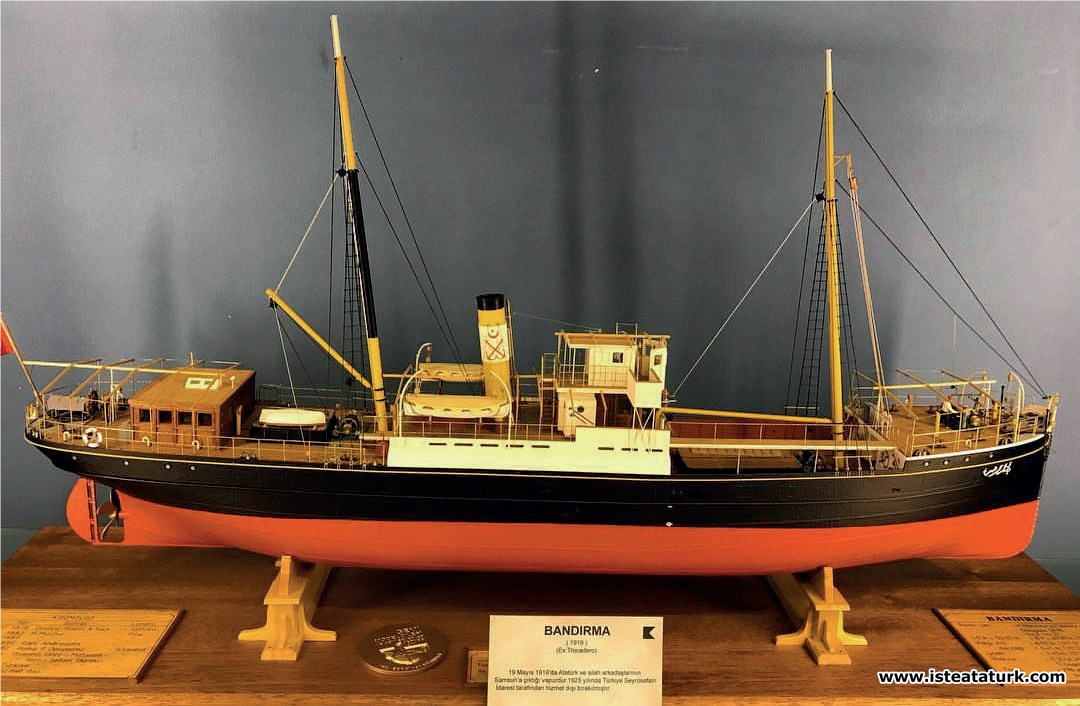
The "Bandırma" ferry in Bodrum Emre Kunt Model Museum has been an excellent model of the original drawing of the ship by Modelmaker Süleyman Alper, achieved in 1/75 scale. Source: Emre Kunt Model Museum.
While the Bandırma Ferry was anchoring in Samsun at 08:15 on Monday, 19 May 1919, İsmail Hakkı Kaptan was enjoying the happiest moment of his life. He was grateful to God for the joy of being able to fulfill this powerful task. Mustafa Kemal Pasha and his comrades set foot ashore from the French-owned Dil (Reji) Pier, where the first step monument is located between today's Samsun Grand Hotel and Yaşar Doğu Sports Hall, via the boat from the Bandırma Ferry, which anchored in the open of Dil Pier. No one knew that the young general, who landed in Samsun on 19 May 1919, would initiate the liberation operation. His official duty was to bring some rebellion gangs to the road in Samsun and its environs. His official title was army inspector.
Name List of the Crew of the Bandırma Ferry who took part in this Sacred Expedition
1. Ship's cavalryman İsmail Hakkı Durusu was born in Kayseri in 1871 and died on 22 December 1940 in Istanbul.
2. First Officer Tahsin Captain from Üsküdar
3. Haci Suleiman, Son of Mehmet Aga, Chief of Wheelsman
4. Ship Clerk Ismail
5. Lostromo Hasan Reis
6. Basri, Son of Ali, from Görele, Chief of Staff
7. Ambarcı Mahmut, Son of Süleyman from Rize
8. Ambarcı, son of Hasan from Silivri, Mehmet
9. Crew Solomon's son Cemil
10. Crew Huseyin Son Rahmi
11. Tayfa Mesut Oglu Temel
12. Haji Tevfik (Ulusu), the son of 1st Steward Muharrera, was born in 1875. On August 1, 1900, he started to work as a steward on the Pleven Ferry with a monthly salary of 200 kuruş, and on October 1, 1914, he was appointed as the 1st Steward of the Bandırma Ferry.
13. Mehmet, Son of Steward Ibrahim
14. Halit, Son of Mustafa, Stewardess Yacht
15. Atesci Koyunhisarli Yusuf Son Halit
16. Fireman Arif Son Mansur from Rize
17. Atesci Osman's Son Haci Hamdi
18. Mehmet, Son of Coalcu Hasan
19. Ömer Faik, son of coal miner Mehmet Ali
20. Vinçci İsmail Hakkı
21. Vinçci Ali Son Galip
Source: Orhan KIZILDEMİR (Turkish Maritime Trade History Researcher)
Mustafa Kemal Pasha, His Staff and Brothers in Arms
1. 9th Army Inspector Mirliva (Brigadier General) Mustafa Kemal Pasha (Atatürk)
2. 3. Corps Commander Erkan-ı Harp Mir Regiment (Staff Colonel) Re'fet (Bele Pasha)
Head of the 3rd Inspectorate Staff Erkan-ı Harp Mir Regiment Manastırlı Kazım (Dirik Pasha)
4th Inspectorate Health Department Head Doctor Miralay İbrahim Tali (Öngören)
5. Deputy Chief of Staff Erkan-ı Harp District Governor (Staff Lieutenant Colonel) Mehmet Arif Bey (Aıcı)
6. Headquarters Erkan-ı War and Intelligence and Political Branch Director Erkan-ı War Major Hüsrev Gerede
7th Inspectorate Artillery residence, Topçu Bin Başı Kemal Bey (Doğan)
8. Medical Inspectorate Deputy Head of Health Department Bin Baş Refik Bey (Saydam)
9th Inspectorate Chief Adjutant Captain Cevat Abbas Bey (Gürer)
10. Dr. Captain Behcet Effendi
11. Staff Annex Mumtaz (Tunay)
12. Staff Annex Captain İsmail Hakkı (Ede)
13th Inspectorate Commanding Officer Captain Ali Şevket (Öndersev)
14. Headquarters Commander Captain Mustafa Vasfi (Süsoy)
15. Added Hundred Head Rauf
16. Captain Ahmet Efendi of Herzegovina
17. Chief of Staff Police Officer First Lieutenant Hayati
18th Staff Annex 3rd Corps Commander Auxiliary First Lieutenant Arif Hikmet (Realistic)
19. IAS Officer First Lieutenant Abdullah (Kunt)
20. Added Lieutenant Psalter
21st Inspectorate Second Aide Lieutenant Muzaffer (Sword)
22nd Adjutant Lieutenant License
23. Legal Advisor Ali Rıza Efendi
24th Battalion Account Officer Rahmi Efendi
25th Battalion Account Officer Ahmet Nuri Efendi
26. First Class Clerk Faik Efendi (Aybars)
27. 4th Class Clerk Memduh Bey (Atasev)
28. Acting Officer Tahir Efendi
29. Regimental Clerk Yahya Efendi
30. Battalion Clerk Süleyman Fehmi Efendi
31. Accounting Officer Şükrü Efendi
32. Ali Faik, Son of Senior Sergeant Osman Nuri
33. Junior Sergeant İbrahim İzzet Son Atif
34. Sergeant Mustafa Son Kemal
35. Sergeant Kemal's son Mustafa
36. Corporal Tevfik's Son Adem
37. Corporal Ali Son Refet
38. Ali, son of Corporal Abdullah
39. Nefer Huseyin Son Mehmet
40. Nefer Ahmet Son Emin
41. Ismail son of Nefer Mustafa
42. Omar, son of Nefer Ibrahim
43. Nefer Kerem's Son Mehmet
44. Mehmet, the son of Nefer Mehmet
45. Ulvan, son of Nefer Hasan
46. Nefer Mehmet Oglu Durmus
47. Ali, the son of Nefer Mehmet
48. Nuri, Son of Nefer Şakir
49. Hussein, son of Nefer Hasan
50. Musa, Son of Nefer Abdullah
51. NeferAbdullah's son Mehmet
52. Hasan, son of Nefer Mehmet
53. Mahmut, the son of Nefer Bekir
54. Mehmet Lütfi, Son of Nefer İhsan
55. A total of 55 people, including Nefer Ali oglu Musa
There were 76 people on board: Atatürk and 22 staff members, 25 privates and non-commissioned officers, 8 consultants and clerks, and 21 ship personnel.
Source: General Staff Atase and Dent. Presidency
